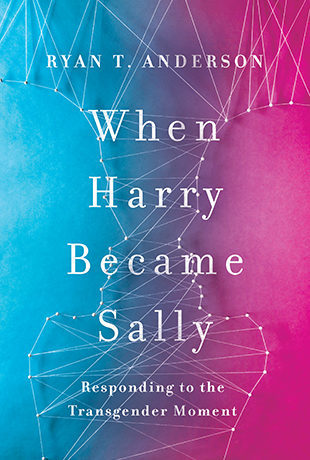When Harry Became Sally by Ryan T. Anderson

(New York: Encounter, 2018), 213
Introduction
The introduction describes what each chapter covers, and provides a good summary of the key points
- Some contradictions in the transgender movement (3-4):
- The real self is separate from the material body, but transforming the body is required for personal wholeness
- Authentic gender identity is tied to stereotypical activities and dispositions, but says that gender is artificially constructed
- Individuals should be free to do whatever they wish, but requires forced conformity of belief
- some people transitioned because they felt they were not accepted; we (especially Christians) need to make them feel welcome as they are (4)
- much of the medical research in this book is by Dr. McHugh and Dr Mayer at Johns Hopkins
- current scientific understanding suggests that the vast majority of children with gender dysphoria (80-90%) will eventually identify with their biological sex
Chapter 1: The Transgender Moment (in Culture, Law, and Medicine)
- chronicles Johns Hopkins, which was a forerunner in transgenderism in the 1960s, stopped, and then resumed in the mid 2000s
Chapter 2: What Transgender Activists Say
- Anderson's observations about transgender activists (28-29)
- They are always changing their creed and expanding their demands
- Even as their position shifts, they are closed off to contrary evidence
- Because the movement is close-minded, it inclines toward coercion
- Transgender Ontology: "at the heart of the transgender moment are radical ideas about the human person—in particular, that people are what they claim to be, regardless of contrary evidence. A transgender boy is a boy, not merely a girl who identifies as a boy." (29)
- Transgender Medicine: typically follows four parts:
- Social transition (name, pronouns, presentation, etc.)
- Psychotherapy to address stigma, social support, etc.
- Hormone therapy
- Surgery
- Transgender Policy: activists demand sweeping policy changes
- Parental Authority: schools have plans in place to keep parents of a kid in the dark about plans to transition him or her (43, cf 2022-01-26 Article-As I Found Out With My Daughter, Not Even Catholic Schools Are Safe Havens From Gender Ideology)
- Transgender Contradictions (45-46):
- The self is other than the physical body (new Gnostic dualism), but they embrace materialist philosophy where only the material world exists
- Gender is purely a social construct, but a person can be "trapped" in the wrong body
- There are no meaningful differences between men and women, but rely on rigid sex stereotypes to argue that "gender identity" is real and human embodiment is not
- The truth is whatever a person says it is, but there is a real self to be discovered inside that person
- Promote radical individualism to define truth however they wish, but force acceptance of transgender ideology
- ...Anderson goes on to ask some pointed questions to transgender activists
Chapter 3: Detransitioners Tell Their Stories
- “What feels easiest isn’t always what’s right.” (Cari-53)
Chapter 4: What Makes Us Man or Woman
- Why "reassignment" is misguided
- walks through the biological definition of sex and sexual differentiation and development in humans
- discusses the very real health differences between the sexes
- discusses disorders of sexual development, which constite classifyable deviation from the male/female norm rather than a "third" or "many" sex phenomena
- distinguishes the political distinction between "disordered" (apart from the norm) and "different" (implying a multiplicity of equally acceptable genders)
Chapter 5: Transgender Identity and Sex "Resassignment"
- defines gender dysphoria
- describes in detail the surgical procedures in "reassignment" surgeries, and describes outcomes of these surgeries
- examines causes of transgender identity
- discusses the level of scientific consensus surrounding transgender surgical procedures and draws attention to the relative lack of certainty and research in this field of study
- identifies Transgenderism is new Gnosticism since it says that humans are non-bodily beings (105)
- we need philosophy in addition to medicine and science to answer metaphysical and moral questions (113-114)
Chapter 6: Childhood Dysphoria and Desistance
- again reviews the prescribed plan of transition for children with gender dysphoria as prescribed by transgender activists, and associated risks and outcomes
- then proposes "a better approach", leaning largely on research by Dr. Kenneth Zucker to encourage a therapeutic approach to alignment with reality rather than a hormonal/surgical approach the other way around on the authority of a child's feelings
Chapter 7: Gender and Culture
- discusses the intersection of Feminism and Transgenderism, which both seek to change or destroy the distinction between the genders
- provides a wonderful view of gender and culture, citing Anthony Esolen (Out of the Ashes) and C.S. Lewis (The Four Loves)
Chapter 8: Policy in the Common Interest
- He focuses on policy concerns surrounding ideology (coercion to the transgender agenda), privacy and security (for non-transgender individuals, especially women), equality (Title IX equality protections for women in danger of reverse, especially for women in sports as the result of competition from transgender "women", who are biological men), redefinition of legal terms by the Obama administration to conform to the transgender agenda, and enforcing transgender orthodoxy through anti-discrimination law
Conclusion
- "When I told people that I was working on a book about the transgender moment, many asked me why. Why spend precious time on something so silly? Why do diligent research and write carefully reasoned arguments about something that runs on emotion? Why open yourself up to charges of transphobia and bigotry? The simple answer is that I couldn't shake from my mind the stories of people who had detransitioned. They are heartbreaking." (205)
- 180-181: key point is that neuroplasticity means that allowing social transition only reaffirms dysphoria and prevents the likely natural return to identifying with actual gender
Topic: Transgender
Created: 2018-04-22
Updated: 2022-03-22-Tue